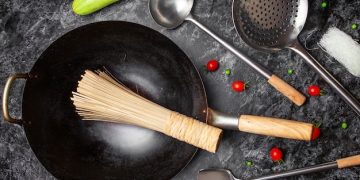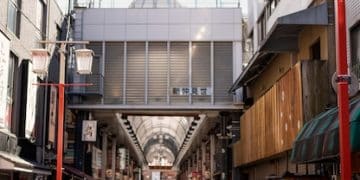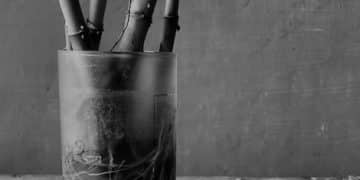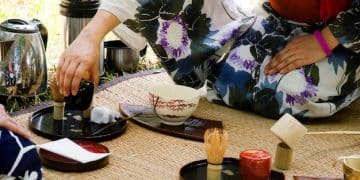The Ultimate Guide to Japanese Tea Ceremony: Etiquette and US Shopping
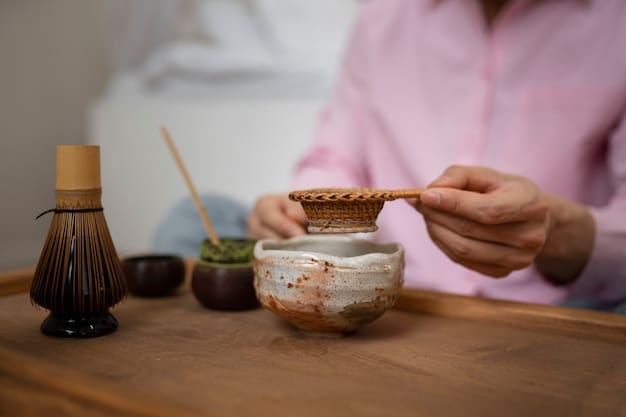
The Ultimate Guide to Japanese Tea Ceremony unveils the art, etiquette, and tools essential for Chanoyu, offering insights into traditional customs and where to purchase authentic tea ceremony supplies in the US.
Embark on a serene journey into the heart of Japanese culture with the ultimate guide to Japanese Tea Ceremony: Etiquette, Tools, and Where to Buy in the US. Uncover the secrets of Chanoyu, a time-honored ritual that embodies harmony, respect, purity, and tranquility, and discover how to recreate this authentic experience in your own home, right here in the United States.
Understanding the Essence of Japanese Tea Ceremony
The Japanese tea ceremony, known as Chanoyu, is more than just preparing and drinking tea. It is a profound cultural ritual steeped in history and philosophy. Understanding its essence is the first step toward appreciating its beauty and significance.
Chanoyu embodies four core principles: harmony (Wa), respect (Kei), purity (Sei), and tranquility (Jaku). These principles guide every aspect of the ceremony, from the selection of utensils to the interactions between the host and guests.
The Historical Roots of Chanoyu
The tea ceremony’s origins can be traced back to 9th century Japan, when tea was introduced from China. Over time, the practice evolved from a medicinal custom to a refined art form, heavily influenced by Zen Buddhism.
- Zen Influence: Zen Buddhism emphasizes mindfulness and the appreciation of simple beauty, which are central to the tea ceremony’s aesthetic.
- Wabi-Sabi: This concept embraces imperfection and impermanence, influencing the rustic and natural elements in the tea room and utensils.
- Tea Masters: Figures like Sen no Rikyū played a pivotal role in codifying the tea ceremony and establishing its enduring principles.
Exploring the historical background enriches your understanding of Chanoyu and allows you to appreciate its evolution as a unique cultural tradition.
In essence, the Japanese tea ceremony is a holistic experience that engages all the senses and promotes a sense of inner peace and connection. By understanding its historical roots and philosophical underpinnings, you can begin to appreciate its profound cultural significance.
Essential Etiquette for the Japanese Tea Ceremony
Proper etiquette is paramount in the Japanese tea ceremony. Adhering to these customs shows respect for the host, the other guests, and the tradition itself. Knowing what to expect will help you fully immerse yourself in the experience.
From entering the tea room to receiving the tea bowl, each action is governed by specific protocols that reflect the principles of harmony and respect. Familiarizing yourself with these customs will enrich your participation and demonstrate your appreciation of Chanoyu.
Navigating the Tea Room
The tea room, or chashitsu, is designed to be a tranquil and minimalist space. Here are some etiquette tips for navigating this environment:
- Entering: Guests typically crawl through a small entrance (nijiriguchi), symbolizing humility and equality.
- Seating: Seating is usually arranged on tatami mats. Observe where the host indicates you should sit.
- Posture: Sit in a formal kneeling position (seiza) unless otherwise directed.
Understanding the protocols for navigating the tea room enhances the serene atmosphere and allows for a more respectful and immersive experience.
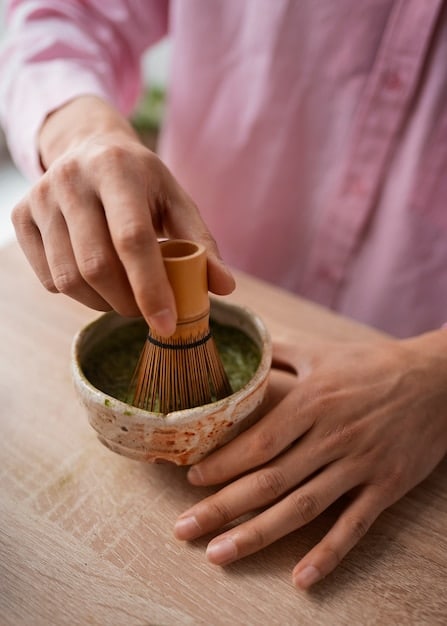
Receiving and Drinking Tea
The act of receiving and drinking tea is a carefully choreographed sequence of movements and gestures. Demonstrating attentiveness and gratitude is key.
When it is your turn to receive tea, follow these steps:
- Bowing: Bow slightly to the host to express gratitude.
- Receiving: Take the tea bowl with your right hand, placing it on your left palm.
- Admiring: Rotate the bowl slightly to avoid drinking from the decorated front.
- Drinking: Take small sips, savoring the flavor and aroma of the matcha.
- Wiping: After the final sip, wipe the rim of the bowl with your fingers and admire the bowl again.
- Returning: Return the bowl to the host, expressing your appreciation with another bow.
Respectfully receiving and drinking tea is a critical element of the ceremony, showing reverence for the occasion and the host’s efforts.
Mastering the etiquette of the Japanese tea ceremony can seem daunting at first, but with practice and mindfulness, it becomes a natural and meaningful part of the experience. By observing these customs, you contribute to the harmony and respect that define Chanoyu.
Tools of the Trade: Essential Tea Ceremony Utensils
The Japanese tea ceremony involves a variety of specialized utensils, each with its own unique purpose and aesthetic. Familiarizing yourself with these tools will deepen your understanding and appreciation of Chanoyu.
These carefully crafted implements are not mere objects; they are integral components of the ritual, chosen for their beauty, functionality, and symbolic significance. Understanding their names and uses allows you to fully appreciate the artistry and precision involved in the tea ceremony.
Key Utensils and Their Uses
Recognizing the purpose and artistry of each utensil emphasizes your appreciation and reverence for the ceremony.
Selecting Quality Utensils
When assembling your tea ceremony set, consider the following factors:
- Material: Opt for high-quality materials like natural bamboo, fine ceramics, and seasoned wood.
- Craftsmanship: Look for utensils that show meticulous attention to detail and reflect the hand of a skilled artisan.
- Aesthetics: Choose utensils that resonate with your personal taste and complement the overall aesthetic of your tea room.
Investing in quality utensils is an investment in the authenticity and enjoyment of your tea ceremony practice.
In conclusion, understanding the essential utensils of the Japanese tea ceremony is crucial for both participants and observers. Recognizing their individual roles contributes directly to an appreciation of the skills and artistic aspects of the ceremony.
Where to Buy Tea Ceremony Supplies in the US
Recreating the Japanese tea ceremony at home requires access to authentic supplies. Fortunately, there are several reputable sources in the US where you can purchase high-quality utensils and ingredients.
Whether you are looking for a complete tea ceremony set or individual items, these retailers offer a curated selection of products that adhere to traditional standards and reflect the artistry of Japanese craftsmanship. Finding reliable sources ensures you have the tools needed to create your experience at home.
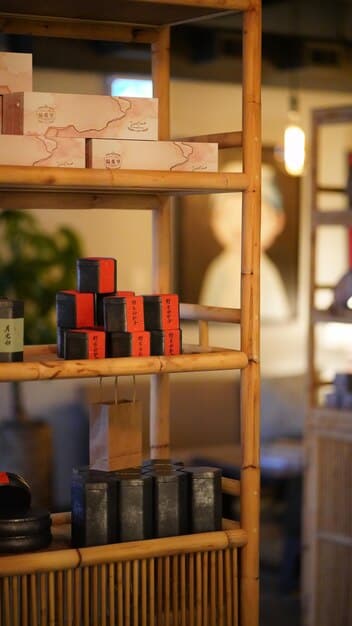
Online Retailers Specializing in Tea Ceremony Goods
Numerous online retailers offer a wide range of tea ceremony supplies, making it convenient to shop from the comfort of your home.
- Yunomi Tea Merchants: Known for their extensive selection of Japanese teas and teaware, including matcha and tea ceremony utensils.
- Breakaway Matcha: Specializes in high-quality matcha and offers a variety of tea ceremony tools and accessories.
- Nio Teas: A reliable source for authentic Japanese tea ceremony supplies, including chawan, chasen, and chashaku.
Exploring online retailers provides access to an array of specialized products, ensuring you can find exactly what you need for your tea ceremony practice.
Brick-and-Mortar Stores in Major US Cities
Several brick-and-mortar stores across the US specialize in Japanese goods, including tea ceremony supplies. Visiting these stores offers a tactile and sensory experience, allowing you to examine the utensils firsthand.
- New York City: Shops like Sunrise Mart and Katagiri offer a selection of tea ceremony items.
- Los Angeles: Stores in Little Tokyo, such as Bunkado, carry a range of traditional Japanese products.
- San Francisco: Japantown offers a variety of stores that sell tea ceremony utensils and matcha.
Visiting physical stores in these areas gives you the opportunity to examine the quality and craftsmanship of tea ceremony utensils up close.
In summary, purchasing tea ceremony supplies in the US has become increasingly accessible, thanks to a combination of online retailers and brick-and-mortar stores. By exploring these options, enthusiasts in the United States can easily obtain the essential tools and ingredients to practice Chanoyu and celebrate Japanese culture at home.
Preparing Matcha: The Heart of the Ceremony
Preparing matcha is a central aspect of the Japanese tea ceremony. The process requires precision and mindfulness, as each step influences the final flavor and texture of the tea.
Mastering the art of whisking matcha can seem challenging at first, but with practice and attention to detail, it becomes a meditative and rewarding experience. Paying attention to water temperature and whisking technique ensures a smooth and frothy cup of tea, true to the tradition of Chanoyu.
Step-by-Step Guide to Preparing Matcha
Follow this guide for preparing matcha:
- Warm the Bowl: Pour hot water into the chawan and warm the bowl. Discard the water and dry the bowl thoroughly.
- Measure the Matcha: Use the chashaku to measure 2 scoops of matcha powder into the bowl.
- Add Water: Pour 2-3 ounces of hot water (around 175°F or 80°C) into the bowl.
- Whisk the Matcha: Use the chasen to whisk the matcha in a “W” or “M” motion until a smooth, frothy consistency is achieved.
- Serve Immediately: Serve the matcha immediately, savoring the vibrant green color and rich aroma.
Tips for a Perfect Bowl of Matcha
- Sifting: Sift the matcha powder before use to remove any clumps and ensure a smoother texture.
- Water Temperature: Avoid using boiling water, as it can scorch the matcha and result in a bitter taste.
- Whisking Technique: Hold the chasen loosely and move your wrist quickly to create a frothy consistency.
In conclusion, preparing matcha involves a delicate balance of skill and mindfulness. By following these steps and tips, you can consistently create a delicious and authentic cup of tea that honors the spirit of the Japanese tea ceremony.
Creating Your Own Tea Room at Home: Tips and Considerations
Creating a dedicated tea room in your home, while not essential, can greatly enhance your experience of the Japanese tea ceremony. A tranquil and minimalist space provides the perfect setting for practicing Chanoyu and immersing yourself in its serene atmosphere.
Converting a spare room or carving out a small corner can transform your home into a sanctuary devoted to harmony, respect, purity, and tranquility. Considering key design elements, from tatami mats to shoji screens, will result in a space that is both functional and aesthetically pleasing, perfect for your tea ceremony practice.
Key Elements of a Traditional Tea Room
- Tatami Mats: These woven straw mats provide a traditional Japanese flooring and contribute to the room’s minimalist aesthetic.
- Shoji Screens: These translucent paper screens allow soft, diffused light to filter into the room, creating a calming ambiance.
- Tokonoma: An alcove for displaying a scroll or flower arrangement, adding a touch of seasonal beauty to the space.
Adapting to Limited Space
If you don’t have a dedicated room, consider these ideas:
- Designated Area: Carve out a corner in a quiet room and decorate it with Japanese-inspired elements.
- Portable Setup: Use a folding screen to create a temporary tea space that can be easily set up and taken down.
- Mindful Arrangement: Focus on creating a sense of calm and simplicity, even in a small space.
| Key Element | Brief Description |
|---|---|
| 🍵 Etiquette | Proper customs for tea room entry, seating, and tea consumption. |
| 🫖 Utensils | Essential tools: chawan, chasen, chashaku, and kama. |
| 🛍️ US Shopping | Where to purchase supplies from online retailers and stores. |
| 🌱 Matcha Prep | How to properly prepare matcha for the ceremony. |
Frequently Asked Questions
▼
Chanoyu is the Japanese tea ceremony, a ritualized way of preparing and drinking matcha tea. It emphasizes harmony, respect, purity, and tranquility.
▼
The essential utensils include the chawan (tea bowl), chasen (bamboo whisk), chashaku (tea scoop), natsume (tea caddy), and kama (iron kettle).
▼
Warm the bowl, measure matcha, add hot water (175°F), and whisk until frothy using a “W” or “M” motion with the chasen.
▼
You can purchase supplies from online retailers like Yunomi Tea Merchants and Breakaway Matcha, or in brick-and-mortar stores in cities like NYC, LA, and SF.
▼
Important etiquette points include bowing to the host, admiring the tea bowl, rotating the bowl before drinking, and taking small sips with appreciation.
Conclusion
Exploring the Japanese tea ceremony offers a profound connection to Japanese culture, promoting mindfulness and tranquility. By understanding the etiquette, tools, and preparation methods, Americans can enrich their practice and foster appreciation for this timeless tradition.
